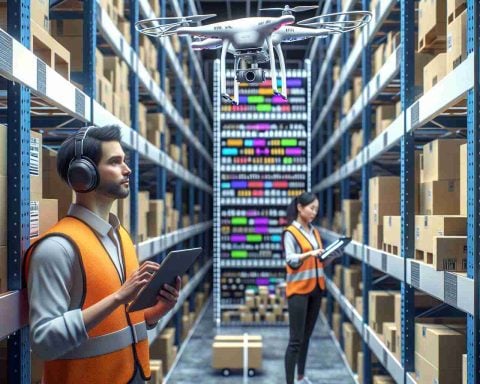- L3Harris has introduced AMORPHOUS, a groundbreaking command and control software for unmanned systems.
- The software enables autonomous command transfers among drones, enhancing operational resilience.
- AMORPHOUS aims to coordinate swarms of over 100 drones, a significant step from current capabilities.
- The system promotes a “leaderless swarm” approach, allowing for more flexible and efficient operations.
- This innovation positions L3Harris as a key player in the evolving landscape of military technology.
- The integration of smart, self-sufficient drone swarms represents a pivotal shift in modern warfare strategies.
In a bold leap towards innovation, L3Harris has unveiled AMORPHOUS, a revolutionary command and control software designed to manage an extraordinary swarm of unmanned systems. Picture a veritable army of drones, autonomously collaborating in real-time to enhance battlefield effectiveness—this is the future of defense!
As military technology evolves, the Pentagon recognizes a critical gap in its drone capabilities. Traditionally, the concept of a “mothership” directing operations has dominated, but L3Harris has a more resilient vision. Instead of relying on a single point of control, AMORPHOUS allows drones to seamlessly transfer command autonomously among themselves, ensuring that even if one asset is compromised, the mission continues unabated.
The software’s full name, the Autonomous Multi-domain Operations Resiliency Platform for Heterogeneous Unmanned Swarms, reflects its ambitious goals. Currently in use across Army contracts and with the Defense Innovation Unit, it has successfully coordinated swarms in the double digits, with aspirations to handle over 100 drones in upcoming tests.
This cutting-edge software advances the concept of a “leaderless swarm,” where a user can command the entire fleet with a simple directive, allowing drones to organize and execute tasks independently. In an arena crowded with competitors like HII and Saab, L3Harris is poised to revolutionize how unmanned systems operate together in joint missions.
The takeaway? The future of warfare rests on smart, self-sufficient drone swarms that can adapt and respond with unparalleled agility—making AMORPHOUS a potential game-changer for modern combat strategies.
Unlocking the Future of Warfare: L3Harris’s AMORPHOUS Command and Control Software
In an age where technology shapes the battlefield, L3Harris is stepping beyond traditional military strategies with its innovative command and control software, AMORPHOUS. This groundbreaking platform is designed to integrate and manage large swarms of unmanned aerial systems (UAS) autonomously. Here’s what you need to know about its features, use cases, and implications for modern warfare.
Key Features of AMORPHOUS
1. Autonomous Command Transfer: Unlike conventional systems that rely on a central commanding unit, AMORPHOUS enables drones to autonomously transfer command among themselves. This resilience ensures mission continuity even in the event of a failure in an individual unit.
2. Scalability: While currently effective with swarms in the double digits, the upcoming tests aim to scale this up to manage over 100 drones working in unison. This scalability could redefine military operations.
3. Leaderless Swarm Concept: AMORPHOUS introduces a leaderless swarm framework, allowing users to issue high-level commands that the drones can interpret and execute autonomously. This reduces the cognitive load on operators and increases operational efficiency.
Use Cases and Market Trends
– Military Applications: Primarily designed for defense, AMORPHOUS enhances reconnaissance, surveillance, and combat capabilities. Its capacity for autonomous adjustment to battlefield conditions makes it a critical asset.
– Commercial and Civil Applications: Beyond military use, similar technologies could have applications in disaster response, environmental monitoring, and autonomous delivery systems.
Limitations and Challenges
– Security Concerns: The autonomy of drone swarms raises potential cybersecurity risks, as compromised units could create vulnerabilities within the larger operation.
– Regulatory Hurdles: Autonomous flying systems face stringent regulations that could limit deployment capabilities, especially in civilian airspace.
Market Forecast
As L3Harris continues to advance AMORPHOUS, the demand for autonomous unmanned systems in both military and commercial sectors is expected to grow. Analysts predict a significant uptick in investment and innovation within this space, leading to more sophisticated deployments of autonomous swarms by 2025.
Important Questions Regarding AMORPHOUS
1. How does AMORPHOUS improve mission resilience compared to traditional command-and-control systems?
– AMORPHOUS’s ability to enable drones to autonomously take control from one another improves resilience by eliminating a single point of failure. This decentralized approach allows for adaptability in dynamic mission environments.
2. In what ways could AMORPHOUS impact future military strategies?
– By facilitating swift, autonomous organization and execution of tasks among drones, AMORPHOUS could shift military strategies towards more flexible, rapid-response operations, thereby enhancing overall effectiveness in combat scenarios.
3. What are the primary security implications of using such advanced drone swarm technologies?
– The decentralized nature poses new cybersecurity risks, as intruders could potentially manipulate the swarm’s operations if they gain access to the system. Continuous vigilance and robust security measures will be essential to safeguard these systems against potential threats.
For more information about L3Harris and their innovative technology solutions, visit L3Harris.




















